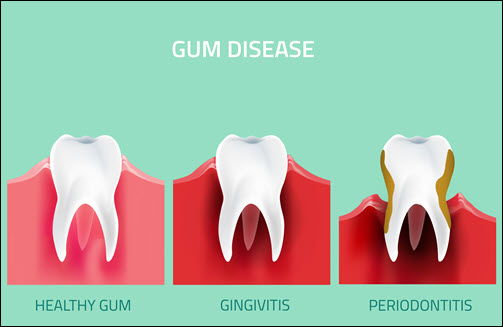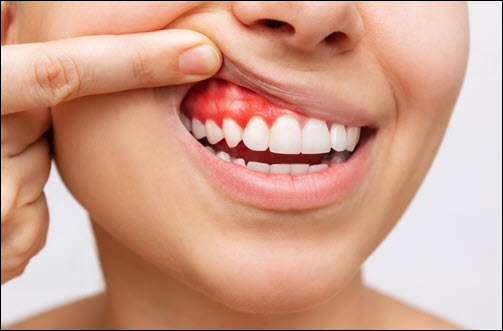In the Know about Periodontal Disease
Periodontal disease, also known as gum disease, is an infection of the gum and bone tissues which surround the teeth. The infection destroys the bone tissue and compromises the support structures which hold the teeth in place. It can affect people of any age, although according to the CDC, there are two main age groups it affects more than others.
- Of adults over the age of 30, 47.2% have some form of periodontal disease.
- The disease becomes more common with age, as 70.1% of adults over the age of 65 have gum disease.
- Also of interest is that it is more common in men.
 Gum disease is usually a result of poor dental habits- namely poor brushing and flossing. This results in a film of bacteria building up and hardening on the teeth. Because of the nature of the disease, it must be treated by a dentist or periodontist.
Gum disease is usually a result of poor dental habits- namely poor brushing and flossing. This results in a film of bacteria building up and hardening on the teeth. Because of the nature of the disease, it must be treated by a dentist or periodontist.
Proactive Steps to Prevent Periodontal Disease
While genetics play a role in one’s risk of gum disease, there are other factors that can contribute the disease.
- Smoking- other than genetics, this is the most common cause.
- Taking medications for diabetes or AIDS
- Poor diet
- Alcohol and drug usage
- Stress
- Hormonal changes
Steps Towards Prevention
Fortunately, there are steps you can take to better your odds at avoiding Periodontal Disease:
- Brush your teeth after eating, paying special care to the spaces between teeth and along the gum line. Don’t overlook the tongue. Brushing it, or using a scraper tool will help remove bacteria, which can turn to plaque.
- Always floss your teeth, ideally at least once a day.
- Use mouthwash to remove any particles that may have been missed by brushing and flossing.
- If you already have crowns or bridge work, be sure it is in place, and not deteriorating in any way.
- Maintain a healthy diet and minimize acidic foods or those high in sugar.
- Find out if periodontal disease is in your genetic makeup. If it is, be vigilant in minimizing risks, such as those listed above.
- Be sure to visit your dentist at least twice a year.
Doing your part to reduce the chances can make a big difference in your dental health.
Symptoms of Periodontal Disease
- Gums – May become red, swollen, and tender. They might also bleed or begin pulling away from your teeth.
- Teeth – If you are developing periodontal disease, you may have pain while chewing. You might also find loose teeth, or suddenly become more sensitive to the temperature of foods.
- Halitosis – Because periodontal disease is a result of bacteria, you may find (or get told) that you have frequent bad breath.
Unfortunately, once you get periodontal disease, it is there to stay. But there are treatments to slow its progress and protect your teeth and gums. Depending on the extent of the disease when you see your dentist, they may do one of three things: crown lengthening, a soft tissue graft, or scaling.
Typically scaling, which is the removal of plaque and tartar that has formed below the gum line, will be the first action taken. Then, to improve the look of your smile, there may be the use of crown lengthening or soft tissue grafting. Crown lengthening is done to remove excess gum tissue and results in the teeth looking shorter. Soft tissue grafting is used to cover the damaged roots and minimize additional gum recession.
If you suspect that you have any of these symptoms, do not hesitate to contact Sauve Family Dentistry. We will assess your situation and determine the next step to happier, healthier smile.




